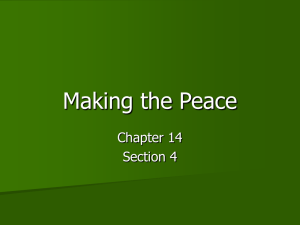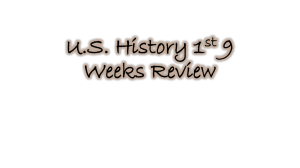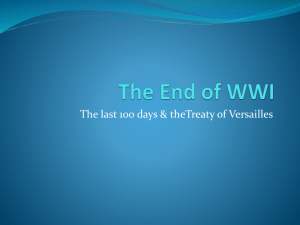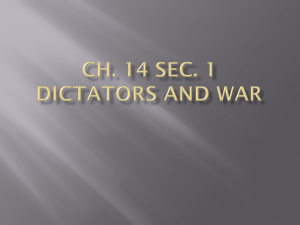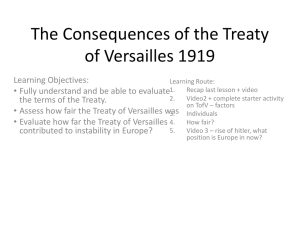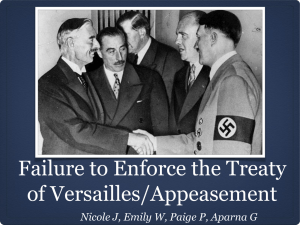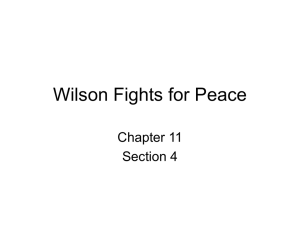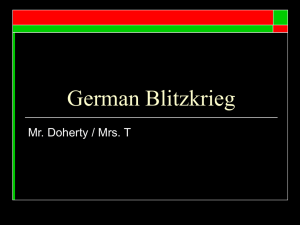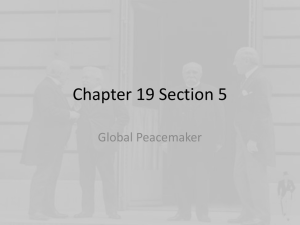21 WW2 Part 1 - Utah Chinese Dual Language Immersion
advertisement
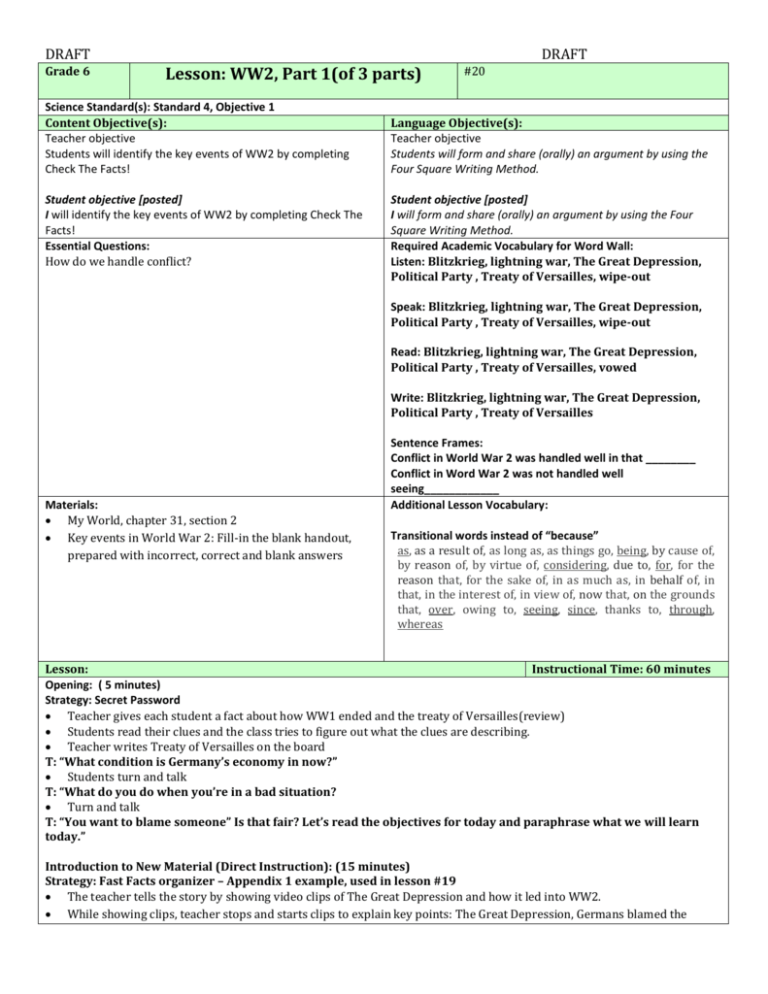
DRAFT Grade 6 DRAFT Lesson: WW2, Part 1(of 3 parts) Science Standard(s): Standard 4, Objective 1 Content Objective(s): Teacher objective Students will identify the key events of WW2 by completing Check The Facts! Student objective [posted] I will identify the key events of WW2 by completing Check The Facts! Essential Questions: How do we handle conflict? #20 Language Objective(s): Teacher objective Students will form and share (orally) an argument by using the Four Square Writing Method. Student objective [posted] I will form and share (orally) an argument by using the Four Square Writing Method. Required Academic Vocabulary for Word Wall: Listen: Blitzkrieg, lightning war, The Great Depression, Political Party , Treaty of Versailles, wipe-out Speak: Blitzkrieg, lightning war, The Great Depression, Political Party , Treaty of Versailles, wipe-out Read: Blitzkrieg, lightning war, The Great Depression, Political Party , Treaty of Versailles, vowed Write: Blitzkrieg, lightning war, The Great Depression, Political Party , Treaty of Versailles Materials: My World, chapter 31, section 2 Key events in World War 2: Fill-in the blank handout, prepared with incorrect, correct and blank answers Sentence Frames: Conflict in World War 2 was handled well in that ________ Conflict in Word War 2 was not handled well seeing____________ Additional Lesson Vocabulary: Transitional words instead of “because” as, as a result of, as long as, as things go, being, by cause of, by reason of, by virtue of, considering, due to, for, for the reason that, for the sake of, in as much as, in behalf of, in that, in the interest of, in view of, now that, on the grounds that, over, owing to, seeing, since, thanks to, through, whereas Lesson: Instructional Time: 60 minutes Opening: ( 5 minutes) Strategy: Secret Password Teacher gives each student a fact about how WW1 ended and the treaty of Versailles(review) Students read their clues and the class tries to figure out what the clues are describing. Teacher writes Treaty of Versailles on the board T: “What condition is Germany’s economy in now?” Students turn and talk T: “What do you do when you’re in a bad situation? Turn and talk T: “You want to blame someone” Is that fair? Let’s read the objectives for today and paraphrase what we will learn today.” Introduction to New Material (Direct Instruction): (15 minutes) Strategy: Fast Facts organizer – Appendix 1 example, used in lesson #19 The teacher tells the story by showing video clips of The Great Depression and how it led into WW2. While showing clips, teacher stops and starts clips to explain key points: The Great Depression, Germans blamed the DRAFT DRAFT Treaty of Versailles and the German Jews for all their economic state,. Adolph Hitler makes himself the dictator to fix problems, starts Nazis political party, goal today Europe tomorrow the world, 1935 started passing laws against the Jews, forms alliance with Italy and Japan, 1939 invades Austria and Czechoslovakia, then Poland, then Britain, France alliance, Soviet Union sign friendship treaty with Germany about sharing Poland, 1939 The allies alliance says if you attack Poland, we’ll attack you, Germany attacks Poland, 1940 Germany takes over France, Belgium, Denmark, the Netherlands and France, Britain, Winston Churchill is fighting with Germany and Hitler uses half his army to fight Britain,. Students complete their Fast Facts organizer Questions Do you think Germany was scared to attack Poland? How long did it take wipe out the Polish air force? Less than 2 days, less than a month to take over Poland How could they take over countries so fast? Had a Blitzkrieg, lightning war Guided Practice: (15 minutes) Strategy: Check the Facts! –Students receive a handout that may or may not have the right answers or may not be complete. They must check the facts in their notes and in the text to be sure the answers are correct. Provide the fill-in-the-blank handout for all students. Create multiple copies with correct, incorrect and missing answers. Give different copies to different students, considering differentiation needs of the learners. Teacher intentionally calls on students who j=have correct, incorrect and blank answers in different order so students must listen and think! Use the modeling cycle: T: “Let’s begin. Student 1 please read number one with the answer. Then student 2 then student 3.” S1: In 1929 the whole world suffered from a severe slowdown in business or an economic crisis called a treaty. S2: In 1929 the whole world suffered from a severe slowdown in business or an economic crisis called a depression. S3: In 1929 the whole world suffered from a severe slowdown in business or an economic crisis called a _______. Uh, it’s blank. T: “That’s right, what should we write?” S3: The Great Depression. T: “If you agree with student 1’s answer put a one in the air with your fingers, now 2, now 3. Talk to someone with a different opinion and show him or her “the facts!” from the text or your notes.” Students discuss, refer to text and notes. T: let’s try that again. Raise a 1,2, or 3. I see some of you changed your answer. Let’s look at the text and our notes to find the answer. I found the answer on page 936 of My World Textbook and it was in my notes. I will read it to you. (read the quote). So the answer is a depression. Now, I’m going to write where I found my answer next to the statement. My World, p. 936. Use this process to guide students through the rest of the fill-in the blank statements. Independent Practice: (20 minutes) Strategy: Four Squares – summarizing Use the Four Square Writing Method to support students in writing an Argument Essay using the events in WW2 they learned today. They may choose from two statements. “Conflict was handled well.” Or “Conflict was not handled well.” Use the Modeling Cycle: Follow the same modeling process used in lesson #12 Closing: (5 minutes) Pair students according to the statement they chose. Pairing statement #1 students with statement #2 students if possible. Students read your Four Squares to a partner. T: “What proof or evidence did you hear your partner say that supported the statement?” Have a few students share examples Assessment: The Four Squares activity and the fill-in the blank assignment. DRAFT Extra Ideas: DRAFT
